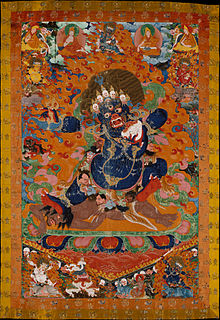Yama
Yama [ˈjɐ. ɱɐ] ( ![]() ) (Sanskrit यम Yama, in India also: Yama-rāja (यमराज, engl. "King Yama"); in Chinese spelling 閻羅王, Yanluowang (Yánluó), short: 閻, alternatively also: 閻魔, 閻羅王, 閻摩羅, 閻老; Tibetan: gshin rje) embodies the Hindu god of death and the "Dharmaraja", the lord of dharma, righteousness. The name Yama means twin, in some stories Yama appears together with his twin sister Yami.
) (Sanskrit यम Yama, in India also: Yama-rāja (यमराज, engl. "King Yama"); in Chinese spelling 閻羅王, Yanluowang (Yánluó), short: 閻, alternatively also: 閻魔, 閻羅王, 閻摩羅, 閻老; Tibetan: gshin rje) embodies the Hindu god of death and the "Dharmaraja", the lord of dharma, righteousness. The name Yama means twin, in some stories Yama appears together with his twin sister Yami.
Yama is referred to in Japanese as Enma, after the Japanese pronunciation of the Chinese characters 閻魔, Yanmo for the phonetic rendering of Yama. More common, however, is the sense rendering of Yama-rāja as Enma-ō (閻魔王, Eng. "King Yama"), alongside its phonetic rendering Enma-raja (閻魔羅闍), as well as Enma-daiō (閻魔大王 ![]() , Eng. "Great King Yama") for Sanskrit Yama-mahārāja. Short forms are Enmara (閻魔羅), Enra-ō (閻羅王), and En (閻).
, Eng. "Great King Yama") for Sanskrit Yama-mahārāja. Short forms are Enmara (閻魔羅), Enra-ō (閻羅王), and En (閻).
For the religious life of the Hindus he hardly plays a role, but mythology knows countless stories in which he appears to fetch his victim. Yama is originally a Vedic deity who rules the underworld (and still strives for enlightenment himself). Life and death are united in him (and his palace). Visitors to the underworld are told by Yama which of the five (six) paths of destiny to follow, based on their karma i.e. the sum of their good and bad deeds.
Tibetan Buddhism
In Tibetan Buddhist myth, the wrathful aspect of the Wisdom Buddha Manjushri subdued Yamantaka Yama and made him a protector of the Dharma. Because of Tsongkhapa's special relationship with Manjushri, he is of great importance in the Gelug school. His consort is Chamundi. In art, Yamantaka is usually shown riding or standing on an ox, trampling on Yama.

Yama in Tibetan representation
See also
- Yamas (and Niyamas) are precepts in yoga
- Jigoku / (Diyu): Buddhist underworld
Search within the encyclopedia